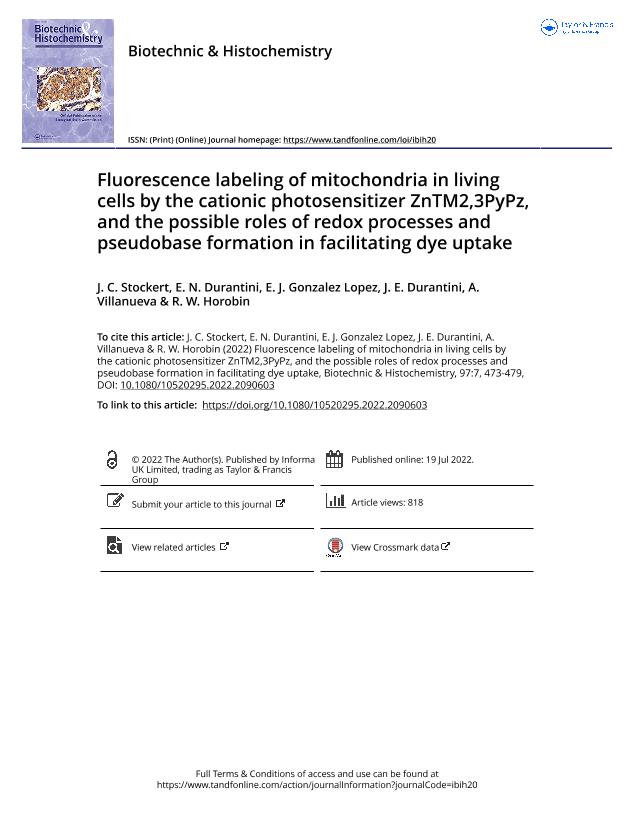Artículo
Fluorescence labeling of mitochondria in living cells by the cationic photosensitizer ZnTM2,3PyPz, and the possible roles of redox processes and pseudobase formation in facilitating dye uptake
Stockert , J. C.; Durantini, Edgardo Néstor ; Gonzalez Lopez, Edwin Javier
; Gonzalez Lopez, Edwin Javier ; Durantini, Javier Esteban
; Durantini, Javier Esteban ; Villanueva, A.; Horobin, R. W.
; Villanueva, A.; Horobin, R. W.
 ; Gonzalez Lopez, Edwin Javier
; Gonzalez Lopez, Edwin Javier ; Durantini, Javier Esteban
; Durantini, Javier Esteban ; Villanueva, A.; Horobin, R. W.
; Villanueva, A.; Horobin, R. W.
Fecha de publicación:
06/2022
Editorial:
Informa Healthcare
Revista:
Biotechnic and Histochemistry
ISSN:
1052-0295
e-ISSN:
1473-7760
Idioma:
Inglés
Tipo de recurso:
Artículo publicado
Clasificación temática:
Resumen
The study of labeling selectivity and mechanisms of fluorescent organelle probes in living cells is of continuing interest in biomedical sciences. The tetracationic phthalocyanine-like ZnTM2,3PyPz photosensitizing dye induces a selective violet fluorescence in mitochondria of living HeLa cells under UV excitation that is due to co-localization of the red signal of the dye with NAD(P)H blue autofluorescence. Both red and blue signals co-localize with the green emission of the mitochondria probe, rhodamine 123. Microscopic observation of mitochondria was improved using image processing and analysis methods. High dye concentration and prolonged incubation time were required to achieve optimal mitochondrial labeling. ZnTM2,3PyPz is a highly cationic, hydrophilic dye, which makes ready entry into living cells unlikely. Redox color changes in solutions of the dye indicate that colorless products are formed by reduction. Spectroscopic studies of dye solutions showed that cycles of alkaline titration from pH 7 to 8.5 followed by acidification to pH 7 first lower, then restore the 640 nm absorption peak by approximately 90%, which can be explained by formation of pseudobases. Both reduction and pseudobase formation result in formation of less highly charged and more lipophilic (cell permeant) derivatives in equilibrium with the parent dye. Some of these are predicted to be lipophilic and therefore membrane-permeant; consequently, low concentrations of such species could be responsible for slow uptake and accumulation in mitochondria of living cells. We discuss the wider implications of such phenomena for uptake of hydrophilic fluorescent probes into living cells.
Archivos asociados
Licencia
Identificadores
Colecciones
Articulos (IDAS)
Articulos de INSTITUTO PARA EL DESARROLLO AGROINDUSTRIAL Y DE LA SALUD
Articulos de INSTITUTO PARA EL DESARROLLO AGROINDUSTRIAL Y DE LA SALUD
Articulos (IITEMA)
Articulos de INSTITUTO DE INVESTIGACIONES EN TECNOLOGIAS ENERGETICAS Y MATERIALES AVANZADOS
Articulos de INSTITUTO DE INVESTIGACIONES EN TECNOLOGIAS ENERGETICAS Y MATERIALES AVANZADOS
Citación
Stockert , J. C.; Durantini, Edgardo Néstor; Gonzalez Lopez, Edwin Javier; Durantini, Javier Esteban; Villanueva, A.; et al.; Fluorescence labeling of mitochondria in living cells by the cationic photosensitizer ZnTM2,3PyPz, and the possible roles of redox processes and pseudobase formation in facilitating dye uptake; Informa Healthcare; Biotechnic and Histochemistry; 97; 7; 6-2022; 473-479
Compartir
Altmétricas



